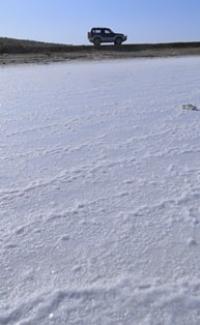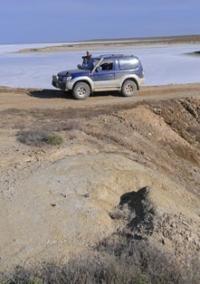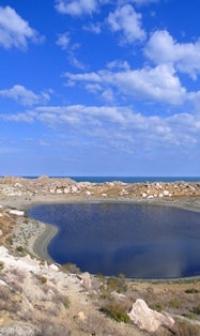Вы здесь
Saline march of Central Asia.




Observing excursion in Samarkand.
“The state is a creation of nature and man is by nature a political animal”
Aristotle.
Guided walking tour in Termez.
Saline march deserts occupy smaller areas than previous ones, meeting with separate spots among other types. At the same time, the factor here is so prominent that the influence of climatic differences seems to be obscured.
The spots of the Saline march desert in the north go beyond the desert climate zone, occurring in the semi-desert zone. However, the Saline march desert is also in the very south of Central Asia - in the form of a significant spot in the Eroylan hollow on the Badkhyz elevation.
The fleshy organs of salads with their watery tissue are reservoirs that fill with water in spring or autumn, when moisture in the soil is more accessible to plants than in summer. In summer, the plant is in an anabiotic state; in the fall, due to a decrease in evaporation and an increase in soil moisture, the salt concentration in the soil decreases and the plant begins to grow vigorously again.
Moisture stored in the spring in the fleshy organs, protects the plant from high concentrations of cell sap in the summer. Limited summer water supply should correspond to weak evaporation. Therefore, the succulent forms of saltworms possess structural features of xerophytes. In some plants, the leaf blade has a cylindrical, filiform form, but many are completely devoid of leaves.
In leafless forms, the function of assimilation is performed by the bark of shoots remaining green until the end of the growing season. In the summer, among the other desert plants of the hodgepodge, the juicy greens of their fleshy organs stand out.
A sign of xeromorphism of fleshy forms of saltworms - thick shoots. Throughout the year, fleshy saltworts are eaten by camels and even sheep, and after frosts in places it is almost the only pasture of sheep. There are plants typical of saline soils, which by the nature of adaptation to the substrate salinity are, as it were, the opposite of succulents.
They do not limit themselves in the consumption of moisture from saline soil solutions, because during the entire vegetative period they emit an excess of salts on the leaf surface, thereby acquiring a grayish or whitish color.
Such plants include grass (Aeluropus), comb dresser, or tamarisk (Tamarix), and others. Often, especially in river valleys, there is a combination of salt marshes and saline march meadows on meadow salt marshes. In the south, it plays a major role in the composition of these meadows, in the northern zone it replaces it (Lasiagrostis splendens).
Saline marshy meadows called Saz. Poverty of the fauna, characteristic of the saline march desert, is associated with poor vegetation development and the soil character unfavorable to the life of animals. Owing to capillary wetting by groundwater and the hygroscopicity of salts, salt marshes are wet and viscous.
The so-called malicious salt marshes, having a solid crust and liquid or semi-liquid mud under it, are widespread. Stepping on such salt marshes, the animals fail and die. In conclusion, we note that the saline desert is a very special physiographic complex with peculiar soils, vegetation, etc.
As a particular subtype of desert landscape, it differs sharply from the others. In general, the example of different types of Central Asian deserts clearly reveals the relationship and interdependence between individual natural components, the dialectical unity of which forms very different types of geographical landscapes belonging to desert types (temperate and subtropical).
Saline march deserts occupy smaller areas than previous ones, meeting with separate spots among other types. At the same time, the factor here is so prominent that the influence of climatic differences seems to be obscured.
The spots of the Saline march desert in the north go beyond the desert climate zone, occurring in the semi-desert zone. However, the Saline march desert is also in the very south of Central Asia - in the form of a significant spot in the Eroylan hollow on the Badkhyz elevation.
The saline march deserts of the northern and southern zones are very similar. Only a few differences in the species composition of the vegetation can be noted; in addition, seasonal variations in salt concentrations of soil solutions are more sharp in the south due to stronger spring soil wetting.
The Saline march desert complex usually develops in relief depressions, where favorable conditions are created for the accumulation of salts. Salts are washed away from the neighboring elevated spaces, and saline groundwater is usually close to the surface, reaching it with its capillary border. In such depressions, salt lakes can periodically exist, drying out during intense heat.
The spots of the Saline march of the desert are located in closed depressions on a plateau, in depressions - stretches of ancient dried river beds and in modern river valleys, along the shores of lakes. Significant saline desert spaces are located on the coast of the Caspian Sea.
The soils of the saline desert - saline march - are divided into two subtypes: Saline march meadow and Saline march typical. In the first case, salt accumulation is combined with a meadow process, which, however, is weakened due to salinization of groundwater.
With an increase in groundwater salinity, typical salt marshes form with a very high salt accumulation. They constitute a large and diverse group, including the saline march plump, crusty and moist. As a result of the secondary salinization of takyr soil and gray earth, takyr soil and gray earth Saline march are formed (soils that are transitional from Saline march to takyr soil and gray earth).
When drying of drainless saline lakes, saline land is formed - deprived of vegetation bottoms of cavities with salt efflorescence and crusts. Saline composition of saline march is different. The most common sulfate chloride and sulfate chloride Saline march.
Saline march of the desert is characterized by a special group of plants - halophytes, which can grow on soils that are saline with chlorides, mainly table salt. Plant habitats are specific and vary only depending on the nature and degree of salinization.
The vegetation of the Saline march of deserts is rather poor and monotonous, since representatives of very few families have the ability to develop on highly saline chlorine-rich soils. In the first place in the landscape of the forming role are the hodgepodge of plants from the family (Chenopodiaceae), widespread throughout the territory of Central Asia.
These include shrubs (Halocnemum strobilaceum), shrubs (Halostachys caspica), herbaceous (Salicornia europaea), various types of saltworms proper (Salsola), (Suaeda), etc. others). Halophytes are mostly succulent, that is, they have fleshy vegetative organs in which moisture accumulates.
The development of halophytes occurs slowly and in conditions changing over the seasons. At the beginning of the growing season, in spring, soil solutions are desalinated by thawing snow and rainwater, but by the end of summer, due to increased evaporation of soil moisture, the salt concentration in soil solutions rises sharply, which worsens the water supply conditions of the plants.
Despite the fact that the soil is saturated with moisture, the phenomenon of so-called physiological dryness occurs. Due to the high concentration of salts in the soil solution, plants can absorb water only in extremely limited quantities and with a high osmotic pressure of cell sap in their tissues.
Halophytes are forced to limit the consumption of moisture for evaporation: during evaporation, there would be a constant flow of salt solutions from the soil into the plant and its tissues would be filled with mineral salts, which would lead to death of the plant.
Fleshy saltwort is very weak, and the moisture from the soil in them goes slowly.
Authority:
N. A. Gvozdetsky, N. I. Mikhaylov. "Physical geography of the USSR. Asian part. The edition third corrected and added. Moscow "Thought" of 1978. http://tapemark.narod.ru/geograf/1_5_5.html
Photos by
Alexander Petrov.







